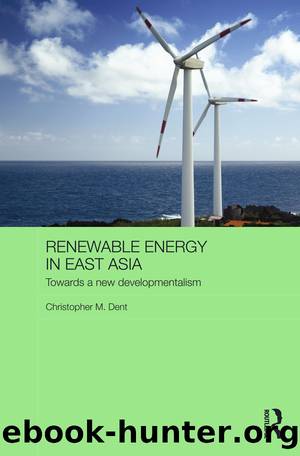Renewable Energy in East Asia: Towards a New Developmentalism by Christopher M. Dent

Author:Christopher M. Dent [Dent, Christopher M.]
Language: eng
Format: epub
Tags: Regional Planning, Ethnic Studies, Public Policy, Developing & Emerging Countries, Social Science, Political Science, Environmental Policy, Regional Studies, General
ISBN: 9781317614425
Google: N0ecBQAAQBAJ
Goodreads: 28024176
Publisher: Routledge
Published: 2014-11-27T00:00:00+00:00
5.5.3.
Domestic market and industry development
5.5.3.1. Solar PV
The development of Chinaâs solar PV market and industry corresponds closely with the substantiation of government policy and strategy toward the sector; the aforementioned 1996 Brightness Programme helped to consolidate the early stages of this development. By 1998, annual PV module production was a mere 2.3 MW capacity equivalent, with a fifth of this being exported. Meanwhile, installed PV capacity had increased from 1.8 MW in 1990 to 19.0 MW by 2000; the vast majority of this was imported and used for off-grid applications in remote parts of the country (Tan et al. 2012, Zhao 2001). At this time, China still lacked indigenous capabilities for PV cell manufacture. The aforementioned policy support measures brought in under the 11th FYP (2006â2010) and 2007 Renewable Energy Plan was to change this. For example, the newly created Institute of Solar Energy and Tianjin Institute of Power Sources collaborated with business on value-chain development and R&D activity to help establish a fast-expanding foundation for industrial-scale PV equipment manufacturing (Wang and Zhai 2012, Yang et al. 2003). In 2000, Chinaâs share of global PV production was just 2 percent, rising to 5 percent by 2004 and 15 percent by 2006. By 2008, the annual national output of PV modules had risen to 2.6 GW (up from 2.3 MW a decade earlier), then to 8.0 GW by 2010 and 23.0 GW by 2012. Correspondingly, Chinaâs share of global production increased to 63 percent by 2012 (EPIA 2011a; Huo and Zhang 2012; IEA 2012c, 2013a; REN21 2013). By 2013, six of the world top-ten PV module producers were Chinese (Table 5.2).
Most of Chinaâs solar PV equipment production (typically around 90 percent) has been exported over the last decade. However, a gradually increasing share of indigenous output is being used for the domestic market due to fast-rising national installed capacity levels. The Chinese PV industry is also very competitive with high rates of business turnover. The IEA (2012c) reported in 2011 that more than half of SMEs in the sub-sector went bankrupt, while small and large firms alike have scaled back production considerably due to over-capacity problems. Chinese dynamic entrepreneurship has led to production supply capacity even outpacing dramatic recent increases in demand. Industry consolidation around the nationâs largest firms has deepened as these firms have become more vertically integrated along the solar PV value chain and have exploited their expanding production scale advantages. By 2012, China had between 20 and 30 manufacturers with substantial production capability in polysilicon, along with more than 60 module producers also making PV wafers and cells (IEA 2013a).
Table 5.2 Worldâs top-10 solar PV module producers, 2006 and 2013
Download
This site does not store any files on its server. We only index and link to content provided by other sites. Please contact the content providers to delete copyright contents if any and email us, we'll remove relevant links or contents immediately.
| Automotive | Engineering |
| Transportation |
Machine Learning at Scale with H2O by Gregory Keys | David Whiting(4179)
Never by Ken Follett(3790)
Urban Outlaw by Magnus Walker(3340)
OPNsense Beginner to Professional by Julio Cesar Bueno de Camargo(3251)
Sapiens and Homo Deus by Yuval Noah Harari(2987)
Will by Will Smith(2793)
A Short History of Nearly Everything by Bryson Bill(2629)
Hooked: A Dark, Contemporary Romance (Never After Series) by Emily McIntire(2500)
Rationality by Steven Pinker(2291)
Borders by unknow(2229)
The Becoming by Nora Roberts(2087)
Holy Bible (NIV) by Zondervan(2086)
The One Percenter Encyclopedia by Bill Hayes(1787)
HBR's 10 Must Reads 2022 by Harvard Business Review(1777)
Freedom by Sonny Barger(1771)
A Short History of War by Jeremy Black(1762)
Five Ways to Fall by K.A. Tucker(1700)
Go Tell the Bees That I Am Gone by Diana Gabaldon(1687)
Girls Auto Clinic Glove Box Guide by Patrice Banks(1685)
